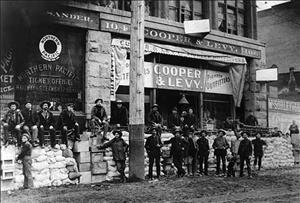Beginning in April 1895, prospectors flow north by the hundreds through the ports of Puget Sound to strike it rich in gold fields in Alaska and in the Yukon Valley of Canada. The travelers feed businesses in Tacoma, Port Townsend, and Seattle, which are suffering from a nationwide economic depression. Additional strikes along tributaries of Canada's Klondike River in August 1896 will turn the flow into a flood.
When Did the Gold Rush Begin?
Most historians mark the arrival in Seattle of 68 miners from Alaska aboard the steamship Portland on July 17, 1897, as the beginning of the Klondike Gold Rush. This is somewhat accurate with regard to strikes along the Klondike River. But the arrival of the miners and their "ton of solid gold" (Lange) was no surprise. Ambitious prospectors had been filling almost every berth and available deck space on ships serving Alaska from Seattle, Tacoma, and Port Townsend for at least two years.
An article datelined Tacoma, April 6, 1895, and titled "Much Gold Found in Alaska," stated the Canadian government had already surveyed a trail to the Yukon from southeast Alaska. From 3,000 to 5,000 prospectors were expected to make the trip that spring. "The practical miners will make money, some of them in large amounts; whether the prospecters [sic] who know nothing about mining are successful will depend largely on their luck. The rate cutting by three steamer lines to Alaskan points, together with the hard times prevailing in the United States has had the effect of sending miners toward the Yukon by the hundred" (The New York Times, April 7, 1895).
Golden Dreams in 1895
The New York Times again mentions gold discoveries in the Yukon on September 21, 1895, in a small item from the Toronto Mail and Empire on page 8. The Mail and Empire printed this:
"Golden dreams have been put in to many a head by the news from Rainy Lake, Seine river, Western Algoma, the Valley of the Yukon, and British Columbia. In all these portions of Canada the yellow metal has been recently uncovered, and in all of them is supposed to be a great store of it. Those youths whose heads were turned by the fairy tales that came from the gold mines of South Africa might have found they could make a fortune with as little magic right at home."
In items datelined San Francisco and Port Townsend, March 6, 1896, The New York Times told of steamships bound for Alaska with prospectors hoping to penetrate 700 miles into the Canadian interior by May. The steamer Topeka left Port Townsend with 300 miners, the largest passenger list ever carried north. Hundreds more men waited for other ships. In 1896, travelers from the East arrived at Tacoma or Seattle by train and took "mosquito fleet" steamers to Port Townsend, which was then the Port of Entry to Puget Sound. "The rush to the north is unprecedented," The New York Times reported.
Unprecedented Rush in 1896
On April 5, 1896, The New York Times printed a lengthy article datelined Tacoma, March 30, and titled, "In Alaskan Gold Fields: An Unprecedented Rush of Miners This Season. Not transportation enough for the men going to the Yukon, Juneau, and Cook's Inlet Districts." Four steamers were serving southeast Alaska and there was not room enough for all who wanted tickets. Nine schooners were expected to join the run. The correspondent reported that prospectors began leaving Tacoma (the terminus of the Northern Pacific Railroad) in January 1896 prepared to stay in the gold country three years. The first gold discoveries were at Cook's Inlet near Anchorage in 1894. Fare to Alaska was $12 for a cabin, $6 for second class.
In addition to the demands of carrying all necessary supplies for three years of work over 750 miles, the correspondent mentioned, "The Yukon mosquito is several times larger and fiercer than that of New Jersey. All the miners carry mosquito netting with them and cover their heads and necks to avoid mosquitos."
The coverage of the rush continued in national papers throughout the summer and fall of 1896. In August 1896, prospectors found gold on Rabbit Creek, which flowed into the Klondike River. Two months later the steamer Lakme docked in Seattle with $200,000 in gold. One L. Laflamme and A. Harrington each had more than $10,000. By noon, local banks had purchased $50,000 of gold. Even several Sisters of the Good Shepherd ponied up dust for cash, but declined to describe how they acquired this wealth.
The arrival of the Portland at Seattle the following summer was the first backwash of the rush that had started at least two years earlier. Whatever the start date for the return of prosperity, Seattle and Tacoma boosters took every opportunity to herald the Klondike Gold Rush and to attract prospectors through their hardware stores, hotels, piers, saloons, gambling dens, and brothels.

